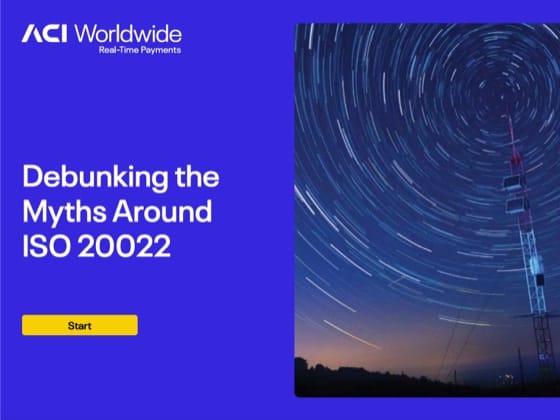ISO 20022 GUIDE
Your Guide to Taking On ISO 20022
What new standards for high-value and real-time payments mean for your financial institution
On This Page
What is the ISO 20022 standard?
ISO 20022 is a global financial messaging standard applied to varied business uses. In all cases, it’s a standardized, robust and machine-friendly data structure rule book designed for today’s modern real-time payments world. ACI supports institutions with award-winning solutions and business knowledge from tenured subject matter experts that center around real-time gross settlement (RTGS), instant payments, ACH, and value-added overlay services.
What do financial institutions need to know about ISO 20022?
The ISO 20022 standard:
- It was issued by the International Organization for Standardization’s Technical Committee 68 in 2004.
- It offers an extensible markup language, XML-based syntax, which allows for increased data volumes, makes parsing financial information easier, and prevents potential truncation and data loss.
- Dramatically increases the number of data points banks can send and receive with payments from approximately 100 to nearly 9,000 characters.
- Interface and machine-friendly, plus helps create a data record along the payments chain.
- More than 70 financial services organizations, including instant payment schemes, Swift, and RTGS schemes, use ISO 20022 today, while others are planning to migrate in 2025.
- Operators have set their deadlines to switch over to the new standard.
Why is standardization important?
Payment messaging standards ensure interoperability between domestic and international RTGS, cross-border payments, instant payments, plus ACH-based networks.
Historically, financial institutions developed products using independent standards. Without universal standardization across payment messaging, that is, without a shared common language, financial institutions can struggle to connect and communicate. This process creates friction, slows down new products to market, and the ability to process cross-border payments or use alternative payment methods.
The ISO 20022 rulebooks, CBPR+, HVPS+, Instant, and ACH, solve this communication issue by creating a common language with extremely marginal deltas. They offer a universal standard for maximum interoperability, providing different payment schemes and financial institutions the flexibility to customize their messaging syntax according to their needs with little effort.
What are the benefits of taking on ISO 20022?
When natively embraced within your ecosystem, there are many benefits to ISO 20022:
- Removes friction when communicating the data from the payment to different systems because even though each system has a distinct business purpose, all systems communicate speaking the same language.
- It exponentially reduces the effort to process a payment across rails without the fear of losing data and further eases the effort of where to put information from field X to Y.
- Saves money by speeding up time to market as rolling out mandates and improvements and introducing new products to the market are completed.
- Reduces the costs of manual investigations due to the improved straight-through processing (STP).
- The rich data also allows for improved fraud prevention and greater compliance with anti-money laundering (AML) regulations.
- ISO 20022 empowers banks to roll out new products and improved services to global customers (e.g., digital overlay services and taking on new payment types one was initially hesitant to progress).
Ultimately, banks must migrate their RTGS and Swift processing systems to ISO 20022 as the payment networks they leverage for their business evolve to this new standard.

Is it enough to convert from legacy to ISO?
A short-term conversion tool, or middleware, can provide connectivity between legacy format and ISO by moving data between the two systems, but it does not ensure compliance or the same interface-friendly usage as the ISO 20022 format. It is not a long-term solution for rolling out new products and payment types.
Conversion limits the granularity of data and how it moves between systems. Passing data from an ISO 20022 format to a legacy format requires truncation. On the outbound side, in most cases, freeform data must be mapped to the ISO freeform fields instead of the ideal granular ISO-equivalent fields. Legacy formats cannot handle rich data, so a significant amount of data will be lost when passed through outbound legacy engines.
Which payment types are moving to ISO 20022?
The ISO 20022 message format is relevant to an ever-growing list including:
- FI to FI Status Report Messages (PACS.002)
- Customer Credit Transfer Messages — Single (PACS.008)
- Customer Credit Transfer Messages — STP_STP EU (PACS.008)
- General Financial Institution Transfer Messages (PACS.009, PACS.009ADV, PACS.009COV)
- Financial Institution Direct Debit Messages (PACS.010)
- Confirmation of Debit/Credit Messages (CAMT.054)
- Customer Statement Messages (CAMT.053)
- Transaction Report Messages (CAMT.052)
- Return of Funds Messages (PACS.004)
- Resolution of Investigation Messages (CAMT.029)
- Payment Cancellation Request Messages (CAMT.056)
- Notification to Receive Messages (CAMT.057)
- System Event Notification Messages (ADMI.004)
- Receipt Acknowledge Messages (ADMI.007)
- Customer Credit Transfer Initiation Messages (PAIN.001)
- Customer Payment Status Report Messages (PAIN.002)
- All Xsys Messages (XSYS.XXX)
What is the timeline for ISO 20022 migration?
There is no singular timeline for ISO 20022 migration. Each financial institution can set its deadline, with some offering co-existing timelines and workarounds.
Important timelines:
- Swift announced a revised migration timeline with an official start date of November 2022 and a deadline of November 2025
- The European Central Bank (ECB) finalized ISO migration in March 20231
- The Bank of England (CHAPS) migrated to the ISO 20022 messaging standard in June 20232
- The Clearing House (CHIPS) migrated in April 2024
- The Federal Reserve’s Fedwire Funds Service ISO 20022 migration is projected to go live by July 2025
How does ISO 20022 relate to cross-border payments?
The ISO 20022 global payments standard allows for greater interoperability when sending transactions across RTGS, Swift and other cross-border schemes. The instant payments industry is taking advantage of this by growing its offering of cross-border payments among instant payment and RTGS schemes.
ISO 20022 also attaches richer data to payments, eliminating the need for manual parsing and creating more detailed payment chains. Financial institutions must be equipped with ISO 20022, sending and receiving rich data while preventing information loss or gaps from forming in the payments chain, to remain relevant.
How can banks migrate to ISO 20022?
Contrary to popular belief, migrating to ISO 20022 does not require a “rip and replace” of legacy systems at step one. ACI offers its domestic RTGS and cross-border payment solutions which protects the existing engine and numerous back-office systems. Acting as a step in the migration process, it ensures compliance against various deadlines, enables banks to manage and leverage rich ISO data, plus streamlines the process for other systems according to their controlled and low-risk timeline.
How long does it take to migrate to ISO 20022?
A typical migration timeline can run anywhere from nine to twelve months, depending on the partner and solution. ACI’s Enterprise Payments Platform is a bank’s ultimate answer to ISO 20022 migration and replaces legacy solutions.
What challenges are associated with ISO 20022 implementation?
Each ISO 20022 migration is distinct, and no two banks’ implementation processes are similar. For this reason, it’s impossible to say what challenges are associated with ISO 20022 implementation; what challenges one financial institution faces, another may not.
There are some general best practices participant banks should follow to ensure a smooth migration process:
- Conduct a thorough gap analysis of core payment processing capabilities to fully understand which systems must undergo modernization for ISO 20022 and how to prioritize those systems.
- Become familiar with each applicable domestic and regional scheme’s ISO 20022 requirements before migration to ensure proper compliance.
- Take a gradual approach, first doing what’s necessary to connect to payment rails and accommodate larger data volumes — for example, setting up end-to-end payment flows for STP — and then migrating over additional systems and interfaces.
- Educate staff on the significance of the new ISO 20022 format and invest in adequate training for new systems.
When adopting a forward-thinking perspective, consider which opportunities to pursue before beginning the migration process and build those opportunities directly into the ISO 20022 strategy.

What kinds of rich-data services are possible with ISO 20022?
The rich data provided by ISO 20022 opens a world of possibilities, from helping banks apply artificial intelligence (AI) to financial advice to speeding up the automated reconciliation of invoices. The growth of alternative payment methods will also be enabled by ISO 20022. The rich data captured will allow forward-thinking banks to better incorporate and deliver on these payment types.
Which payment schemes/systems are already using ISO 20022?
Swift has supported ISO 20022 for some time now, called SWIFT MX. SWIFT MX is optional and uses a different set of ISO 20022 rules. As of September 2019, ten high-value payment schemes are live on ISO 20022. China’s CNAPs and Japan’s NET are two examples. As of March 2022, Swift now supports the CBPR+ rulebook. ISO 20022-based instant payment systems continue to grow globally to come to market.
What is the difference between Swift FIN (MT) messages and RTGS legacy messages compared to the new ISO 20022 format?
ISO 20022 messaging allows for data-rich transmissions that were not previously possible with legacy formats used by SWIFT and SWIFT-like regional and domestic schemes. ISO 20022 is exponentially larger than any legacy non-ISO layout with field lengths, numbers of fields, and now all the different business types of fields.
For instance, using legacy structures to process one transaction, the financial institution would send a payment message followed by an informational message with all the data that would not fit in the payment. Further, the receiving financial institution must receive both and cross-reference the message to process the transaction. ISO 20022 puts all the information into one transaction, improving efficiency, costs, and speed.
What is the ISO 20022 equivalent of an MT103 message?
To directly answer the question, the ISO 20022 Customer Transfer message type PACS.008 is the equivalent of an MT103. It’s also worth noting that a Bank-to-Bank Transfer and PACS.009 is the equivalent of an MT202 and MT205, PACS.009 Cov is equivalent to MT202 Cov.
All high-value payment schemes converting to ISO 20022 — including Swift-like schemes, pan-regional schemes, and domestic schemes — typically use the same message types to address their payments. These message types include PACS.008, PACS.009, PACS.004, PACS.002, and a handful of CAMT.xxx message types.
Finally, a return — whether Customer Return (MT103 Return) or Bank Return (MT202 Return) — a PACS.004 is used, with some granularity distinction noted in the payload of the data.

Do banks need to be able to send and receive ISO 20022 messages within the Swift and RTGS worlds?
While Swift and select schemes offer co-existing periods until 2025, banks must be able to send and receive ISO 20022 messages for high-value payment rails to remain compliant with network and system updates on behalf of their customers. Correspondent banks must be able to pass structured, enriched data to the next party in the chain, as well as receive new ISO 20022 messages from across their global network of partner financial institutions.
Is migrating to ISO 20022 mandatory?
Various real-time gross settlement (RTGS) domestic and regional schemes have mandated the new ISO 20022 standards to allow them to establish a migration timeline. Swift offers coexisting periods during which the FIN and ISO 20022 messages are accepted.

Is it a case of Swift GPI vs. ISO 20022, or Swift GPI and ISO 20022?
Swift GPI and ISO 20022 are separate initiatives but can open the door to real-time payments and new value-added services, especially when high-value payment schemes go to ISO 20022. Given most instant payment schemes are ISO 20022-based, there is friction in translating the message to and from the legacy high-value payments system. When the high-value payment schemes migrate to ISO 20022, it will become almost seamless for a financial institution to leverage high-value and instant payment schemes. SWIFT gpi Instant (gInstant) is a payment with three features:
- The payment can be domestic or cross-border, but must be sent through a high-value payments scheme
- The payment must be marked with the associated GPI Service Call
- The payment should originate and/or settle into an instant payments scheme
When the instant payments scheme gives the originating financial institution the response, the originator returns a response to the recipient so the other financial institutions are notified of the outcome.

What’s the impact of ISO 20022 on Universal Confirmations?
For many smaller financial institutions, where adhering to the level of SLA required under Swift GPI is not feasible, they use Universal Confirmations, a smaller scope of messaging types that have a lower level response time mandate. Only customer transfers are required to respond to the Swift GPI Tracker, and the response has a slower SLA response time. This task is not related to high-value payment schemes migrating to ISO 20022. The impact is on Credit Transfers (MT103 migrating to PACS.008).
Article Sources
- European Central Bank, “Successful launch of new T2 wholesale payment system, https://www.ecb.europa.eu/press/pr/date/2023/html/ecb.pr230321~f5c7bddf6d.en.html.” ↩︎
- Bank of England, “ISO 20022: Implementing the global payments messaging standard within CHAPS and RTGS, https://www.bankofengland.co.uk/payment-and-settlement/rtgs-renewal-programme/iso-20022.” ↩︎
A Guide to ISO 20022 Implementation Strategies
Get an in-depth look at how banks can adopt and leverage this data-rich messaging standard to drive new revenues